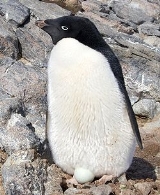
Adelie Penguin
Overview
Penguin
Penguins are a group of aquatic, flightless birds living almost exclusively in the southern hemisphere, especially in Antarctica. Highly adapted for life in the water, penguins have countershaded dark and white plumage, and their wings have become flippers...
common along the entire Antarctic
Antarctic
The Antarctic is the region around the Earth's South Pole, opposite the Arctic region around the North Pole. The Antarctic comprises the continent of Antarctica and the ice shelves, waters and island territories in the Southern Ocean situated south of the Antarctic Convergence...
coast. They are among the most southerly distributed of all seabird
Seabird
Seabirds are birds that have adapted to life within the marine environment. While seabirds vary greatly in lifestyle, behaviour and physiology, they often exhibit striking convergent evolution, as the same environmental problems and feeding niches have resulted in similar adaptations...
s, as are the Emperor Penguin
Emperor Penguin
The Emperor Penguin is the tallest and heaviest of all living penguin species and is endemic to Antarctica. The male and female are similar in plumage and size, reaching in height and weighing anywhere from . The dorsal side and head are black and sharply delineated from the white belly,...
, the South Polar Skua
South Polar Skua
The South Polar Skua, Stercorarius maccormicki, is a large seabird in the skua family Stercorariidae. An older name for the bird is MacCormick’s Skua, after explorer and naval surgeon Robert McCormick, who first collected the type specimen...
, the Wilson's Storm Petrel, the Snow Petrel
Snow Petrel
The Snow Petrel is the only member of the genus Pagodroma. It is one of only three birds that breed exclusively in Antarctica and has been seen at the South Pole. It has the most southerly breeding distribution of any bird.-Taxonomy:...
, and the Antarctic Petrel
Antarctic Petrel
The Antarctic Petrel is a boldly marked dark brown and white petrel, found in Antarctica, most commonly in the Ross and Weddell seas. They eat Antarctic krill, fish, and small squid...
. In 1840, French explorer Jules Dumont d'Urville
Jules Dumont d'Urville
Jules Sébastien César Dumont d'Urville was a French explorer, naval officer and rear admiral, who explored the south and western Pacific, Australia, New Zealand and Antarctica.-Childhood:Dumont was born at Condé-sur-Noireau...
named them for his wife, Adéle.
The Adélie Penguin is one of three species in the genus Pygoscelis
Pygoscelis
The genus Pygoscelis contains three living species of penguins collectively known as "The Brush-Tailed Penguins". Their appearance - black above, white below - is the stereotypical image of penguins, and so what most people think of when they think of penguins.-Taxonomy:Mitochondrial and nuclear...
. Mitochondrial
Mitochondrion
In cell biology, a mitochondrion is a membrane-enclosed organelle found in most eukaryotic cells. These organelles range from 0.5 to 1.0 micrometers in diameter...
and nuclear
Cell nucleus
In cell biology, the nucleus is a membrane-enclosed organelle found in eukaryotic cells. It contains most of the cell's genetic material, organized as multiple long linear DNA molecules in complex with a large variety of proteins, such as histones, to form chromosomes. The genes within these...
DNA
DNA
Deoxyribonucleic acid is a nucleic acid that contains the genetic instructions used in the development and functioning of all known living organisms . The DNA segments that carry this genetic information are called genes, but other DNA sequences have structural purposes, or are involved in...
evidence suggests the genus
Genus
In biology, a genus is a low-level taxonomic rank used in the biological classification of living and fossil organisms, which is an example of definition by genus and differentia...
split from other penguins around 38 million years ago, about 2 million years after the ancestors of the genus Aptenodytes
Aptenodytes
The genus Aptenodytes contains two extant species of penguins collectively known as "the great penguins".-Taxonomy:...
.
Discussions

